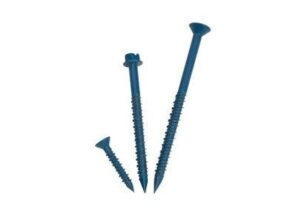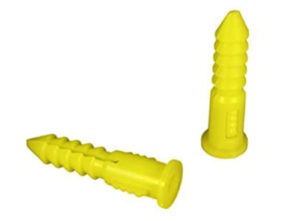
Pallet racks are essential to warehouses and retail centers, as well as to many industrial and commercial facilities. Regardless of the facility, all pallet racks must be anchored for stability and security.
There are several common types of pallet racks available, with each type designed for specific functions.
The type of racking required depends on certain factors:
- desired storage density
- inventory rotation
- storage design
Some types of pallet racks include:
- selective
- structural
- push back
- narrow
Once the type of pallet racking has been determined, a floor plan must be designed to allow for adequate aisle spacing. If the storage space requires a tighter configuration, then pallet racking designed for narrow aisles is available.
After the facility racking floor plan is designed and the racks are assembled, the decision to purchase the anchors to secure the racks to the concrete slab then must be carefully considered.
Tip
A vertical tolerance of 1/8″ in 4 feet is generally accepted as level in most applications.
It is critical to ensure that all the racks are level before installing any anchors or screws. It is also essential to ensure that every column of the rack frame will be anchored to an adequate and stable concrete floor. Deciding which anchor to use is typically based on the manufacturer’s recommendation and/or personal preference.
Wedge Anchors
One option for fastening pallet racks is the use of a concrete wedge anchor. Wedge anchors are available in a variety of diameters and lengths and are specifically designed for use in solid concrete. The diameter to be used in each application is dependent upon the hole size in the bottom plate of the upright. Most racking systems have holes that will accommodate a 1/2″ diameter wedge anchor. The 1/2″ anchor is available in 8 different lengths ranging from 2 3/4″ to 12″. The most commonly used lengths for fastening pallet racks are the 3 3/4″ and 4 1/4″.
Size of Wedge Anchor
Another essential consideration is to determine the required holding values for the chosen anchor. Once the holding values are calculated and verified, refer to the wedge anchor technical specifications technical chart to select the size of anchor required. If unsure of the correct size anchor to use, it is recommended to check local building codes or have an engineer determine the requirements for the application. The pallet rack manufacturer may also suggest an anchor size to use.
The installation of concrete wedge anchors
- Using the hole in the bottom plate as a template, carefully drill holes using a hammer drill and carbide-tipped masonry bit. The drill bit diameter should be the same diameter as the wedge anchor.
- Clear the holes of all debris using compressed air, a shop-vac or wire brush.
- Before inserting the wedge anchor into the hole, be sure to place the washer and thread the nut a couple of turns. Not fully threading the nut protects the threads of the wedge anchor.
- Insert the wedge anchors into each hole through the upright legs of the pallet racks.
- Carefully hammer the anchors into each hole ensuring that they are installed to the desired depth.
- Tighten all the nuts using a torque wrench to ensure they are tightened to the required torque value.
When using the concrete wedge anchor, it is important to remember:
- Wedge anchors are very effective when the concrete is in good condition and minimum edge distances and spacing are maintained.
- Hole size is critical to the holding values of the wedge anchor. Hole diameter is equal to the anchor diameter when using ANSI standard carbide bits. The tolerances of the ANSI standard carbide bits are specifically matched to wedge anchor diameters.
- Wedge anchors have a required torque value. See the technical information page to determine the diameter of the anchor to use for a range of required torque values.
Some installers of pallet racks choose to use hex head large diameter concrete screws. It is recommended to use high-quality concrete screws that are specifically designed for heavy-duty applications, such as installing pallet racks. This will ensure a secure and long-lasting installation that can withstand the weight of the pallet racks and their contents.
Products Features Include
- EASY TO INSTALL: Fast, secure installation
- EASY TOREMOVE: Simply turn clockwise and back the screw out of the hole
- ONE PIECE DESIGN: No nuts or washers the anchor comes complete
Applications
The anchor is made from hardened carbon steel zinc plated. This anchor is designed for use in Concrete, Block, and Brick.
Environment
The anchor is designed for use in a dry environment.
Head Style
The anchor is a Hex Washer Serrated head and is designed to allow the head to sit on top of the surface of the item being attached.
Installation of Hex Head Concrete Screws
Hole Diameter/Bit Diameter
The anchor requires a 1/2″ hole to be drilled in the base material (Concrete, Block, and Brick). The hole should be drilled with carbide tipped bit that meets ANSI standards and also used in a hammer drill.
Driver Required
A 3/4″ is required for driving the anchor into the base material.
Minimum Embedment
The minimum anchor embedment into the concrete is 2″. Therefore, the anchor must be installed so that a minimum of 2″ of the anchor is embedded into the concrete.
Depth of Hole
The depth of the hole that is required for the anchor should be a minimum of 1/2″ deeper than the anchor will penetrate the concrete. This will allow space for dust created during the installation process to fall, which will prevent the anchor from bottoming out in the hole before full penetration into the concrete.
Maximum Fixture Thickness
The maximum fixture thickness or the maximum thickness of the material being fastened for a anchor is 2″. This will ensure that the minimum embedment of 2″ will be met.
Fixture Hole Diameter
The hole in the fixture or material being fastened must be larger than the designated diameter of the anchor. The 1/2″ diameter anchor requires the hole in the fixture to be 9/16″.
Wrench Size
The size of the wrench required to turn the nut to set the anchor is 3/4″.
Spacing between Anchors
Each anchor must be spaced a minimum distance of 8″ from each other when measured center to center.
Edge Distance
It is very important not to install the anchor any closer than 5″ from an unsupported edge of the concrete.
Holding Values
A safety factor of 4:1 or 25% is generally accepted as a safe working load. It is also recommended to check local building codes or have an engineer determine the requirements for the application as well.














